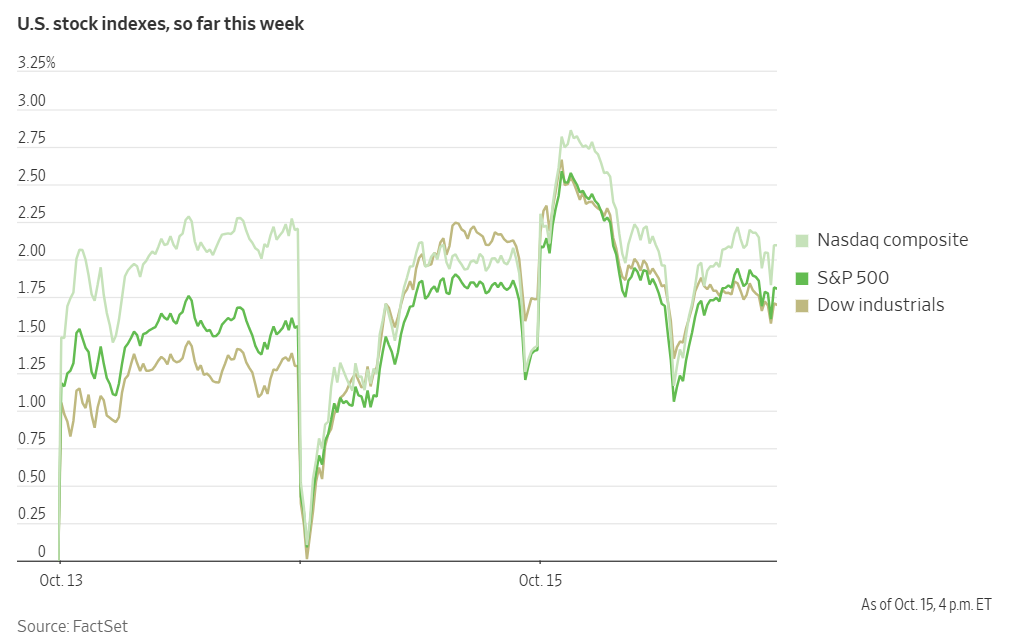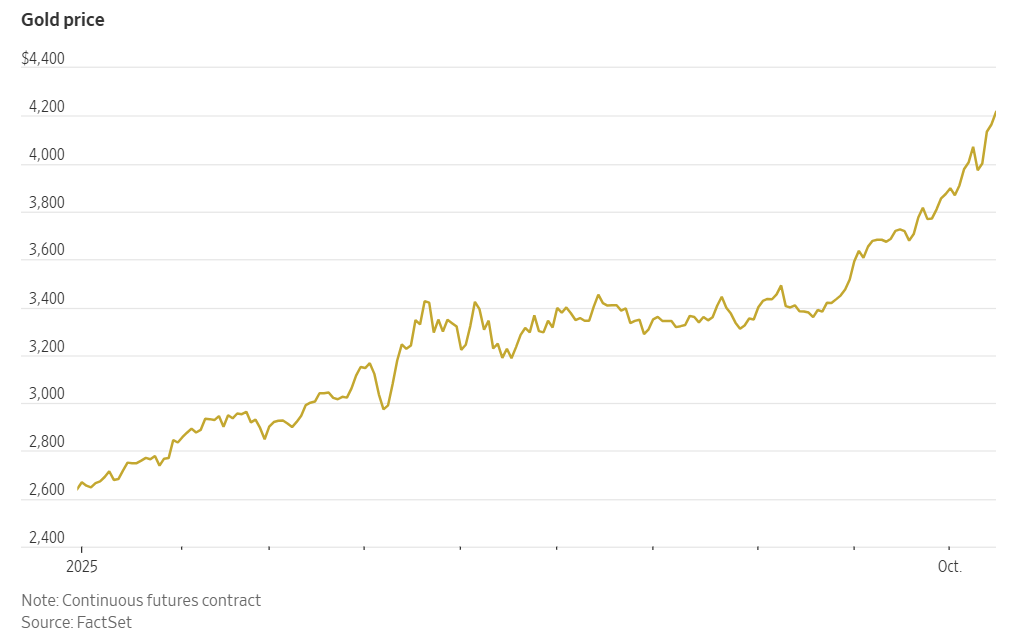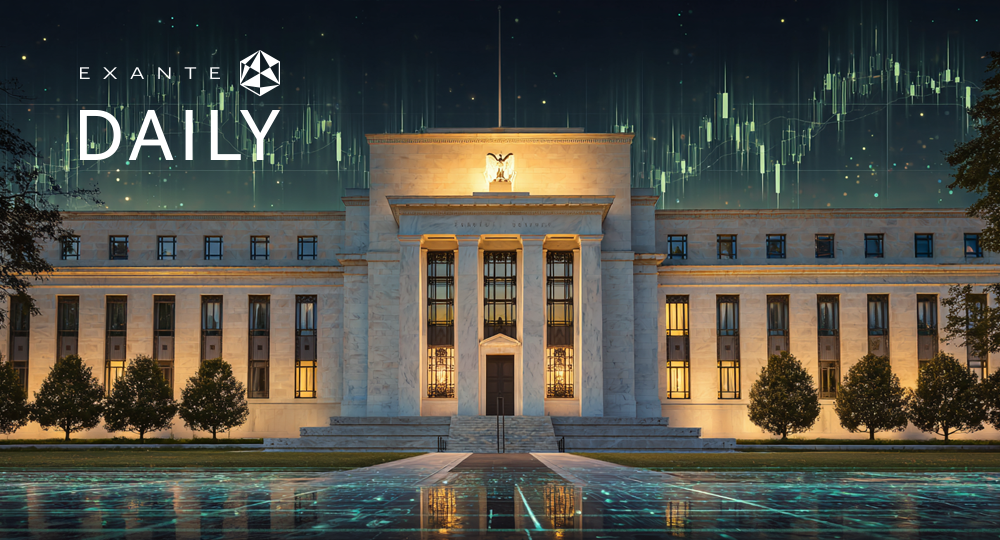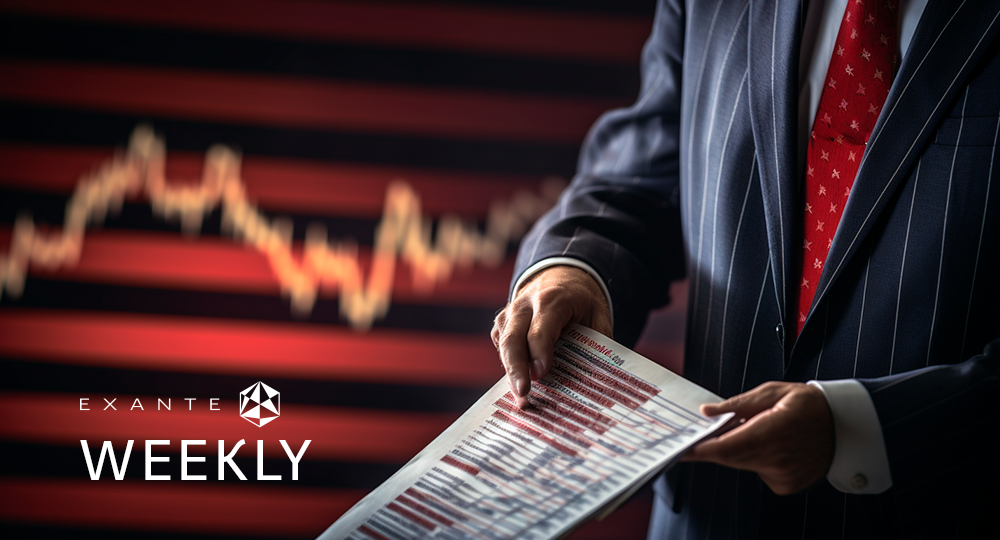
Will there be a trade war truce?

Corporate Earnings Calendar 16th October - 22nd October 2025
Thursday: Taiwan Semiconductor Manufacturing, Charles Schwab, Bank of New York Mellon, Travelers, Snap-On, US Bancorp, Marsh & McLennan, United Airlines, CSX
Friday: American Express, State Street, Schlumberger, Truist Financial, Fifth Third Bancorp, Volvo
Monday: WR Berkley
Tuesday: Steel Dynamics, GE Aerospace, General Motors, The Coca-Cola Company, RTX, Halliburton, 3M, Equifax, Philip Morris International, Lockheed Martin, Netflix, Northrop Grumman, Capital One Financial, Chubb, L’Oreal, Texas Instruments
Wednesday: AT&T, Boston Scientific, CME Group, Thermo Fisher Scientific, Northern Trust, EQT, IBM, Tesla, Crown Castle, Teledyne Technologies, Hilton Worldwide Holdings, GE Vernova, Barclays, Hermes International
Global market indices
US Stock Indices Price Performance
Nasdaq 100 +0.26% MTD and +17.77% YTD
Dow Jones Industrial Average -0.27% MTD and +8.76% YTD
NYSE +0.03% MTD and +12.95% YTD
S&P 500 -0.26% MTD and +13.42% YTD
The S&P 500 is -1.22% over the past seven days, with 8 of the 11 sectors down MTD. The Equally Weighted version of the S&P 500 is -1.12% over this past week and +7.77% YTD.
The S&P 500 Utilities sector is the leading sector so far this month, +6.40% MTD and +22.50% YTD, while Energy is the weakest sector at -3.15% MTD and +0.99% YTD.
Over this past week, Consumer Staples outperformed within the S&P 500 at +2.37%, followed by Utilities and Real Estate at +2.30% and +1.48%, respectively. Conversely, Energy underperformed at -2.85%, followed by Information Technology and Industrials at -2.52% and -1.95%, respectively.
The equal-weight version of the S&P 500 was +0.17% on Wednesday, underperforming its cap-weighted counterpart by 0.23 percentage points.

The six largest banks in the US collectively earned nearly $41 billion in Q3, representing a 19% increase y/o/y. This growth was driven in part by robust performance in dealmaking and trading activities. Shares of Morgan Stanley rose by 4.7% following Q3 results that exceeded expectations, while Bank of America saw its stock climb 4.4% in response to a similar Q3 beat.
Stock market activity on Wednesday was mixed. The Nasdaq Composite Index advanced by +0.66% and the S&P 500 gained +0.40%. The Dow Jones Industrial Average slipped marginally, declining by 17 points, or -0.17%.
In corporate news, Apple unveiled updated versions of the iPad Pro, Vision Pro, and the entry-level MacBook Pro equipped with the new M5 chip, strategically introducing these products ahead of the critical holiday shopping season.
ASML Holding reported a significant surge in demand for its advanced chip-manufacturing equipment, attributing the uptick to the growing influence of AI. This improved outlook comes just months after the company cautioned that the ongoing trade war could hinder future growth.
Papa John’s International shares rose after Reuters disclosed that Apollo Global Management submitted a proposal to acquire the pizza chain operator at $64 per share.
Investors led by BlackRock’s Global Infrastructure Partners agreed to acquire Aligned Data Centers in a $40 billion deal. This acquisition marks one of BlackRock's largest investments in infrastructure to date and reflects Wall Street’s ongoing efforts to capitalise on the AI sector.
Lone Star Funds has revealed plans to purchase Hillenbrand, a US manufacturer of plastic components and equipment, through an all-cash transaction worth approximately $3.8 billion, including debt.
Novo Nordisk reached an agreement to pay Omeros up to $2.1 billion for the rights to an experimental drug targeting rare diseases. This move underscores Novo Nordisk’s strategy of using dealmaking to strengthen its product pipeline.
Alphabet’s Waymo is preparing to launch its autonomous ride-hailing service in London next year, marking its second international expansion.
TotalEnergies announced that its Q3 profit and cash flow are expected to increase slightly, driven by higher oil and gas production and improved refining margins compared to the previous year, despite a decline in crude oil prices.
Mega caps: The Magnificent Seven had a negative performance over the past week. Over the last seven days, Alphabet +2.62%, while Meta Platforms -0.04%, Tesla -0.81%, Microsoft -2.18%, Apple -3.38%, Amazon -4.28%, and Nvidia -4.91%.
Energy stocks had a negative performance this week, with the Energy sector itself -2.85%. WTI and Brent prices are -5.56% and -5.47%, respectively, over the past week. Over the last seven days, Energy Fuels +39.53%, while Chevron -1.06%, Phillips 66 -1.32%, ExxonMobil -2.11%, Marathon Petroleum -2.59%, Shell -2.62%, BP -3.78%, APA -5.53%, Halliburton -6.40%, ConocoPhillips -6.41%, Occidental Petroleum -7.02%, and Baker Hughes -7.06%.
Materials and Mining stocks had a mixed performance this week, with the Materials sector -1.43%. Over the past seven days, Albemarle +7.06%, Newmont Corporation +5.86%, and Yara International +2.17%, while Nucor -0.78%, Sibanye Stillwater -1.90%, Freeport-McMoRan -2.66%, Celanese Corporation -5.72%, CF Industries -5.79%, and Mosaic -14.37%.
European Stock Indices Price Performance
Stoxx 600 +1.72% MTD and +11.85% YTD
DAX +1.26% MTD and +21.46% YTD
CAC 40 +2.29% MTD and +9.43% YTD
IBEX 35 +0.62% MTD and +34.28% YTD
FTSE MIB -1.52% MTD and +23.08% YTD
FTSE 100 +0.79% MTD and +15.32% YTD
This week, the pan-European Stoxx Europe 600 index is -1.05%. It was +0.57% on Wednesday, closing at 567.77.
So far this month in the STOXX Europe 600, Health Care is the leading sector, +6.06% MTD and +0.08% YTD, while Autos & Parts is the weakest at -7.66% MTD and -12.90% YTD.
This week, Telecommunications outperformed within the STOXX Europe 600, at +2.29%, followed by Utilities and Food & Beverages at +2.27% and +1.41%, respectively. Conversely, Autos & Parts underperformed at -9.03%, followed by Industrial Goods and Oil & Gas at -2.50% and -2.22%, respectively.
Germany's DAX index was -0.23% on Wednesday, closing at 24,181.37. It was -1.69% over the past seven days. France's CAC 40 index was +1.99% on Wednesday, closing at 8,007.00. It was +0.21% over the past week.
The UK's FTSE 100 index was -1.30% over the past seven days to 9,424.75. It was -0.30% on Wednesday.
In Wednesday's trading session, the Personal & Household Goods sector in the STOXX 600 outperformed, primarily driven by a rally in luxury stocks. This shift followed a better-than-expected Q3 earnings report from LVMH Moët Hennessy Louis Vuitton (LVMH). Adding to the momentum, Deutsche Bank upgraded both Burberry and LVMH to ‘Buy’, citing more favourable upcoming financial comparisons. Analysts at Kepler Cheuvreux and JPMorgan corroborated the positive outlook, highlighting stabilising demand in China and the resilient luxury goods segment in the US.
The Technology sector also advanced, with ASML Holding announcing Q3 profit margins that beat expectations and reporting a robust €5.4 billion in new bookings, signalling healthy demand for semiconductor manufacturing equipment. The Construction & Materials sector also strengthened, driven by significant activity in heavy construction companies. Bouygues’ stock rallied after joining Free-iliad and Orange in a joint non-binding €17 billion offer for parts of Altice France. Strabag advanced notwithstanding the announcement that its principal shareholder intends to divest 2.5 million shares.
Other sectors also traded higher. Chemicals outperformed, led by BASF after Citigroup resumed its coverage with a ‘Buy’ rating. Concurrently, reports indicate that the Abu Dhabi National Oil Company is nearing EU approval for its bid for Covestro. Basic Resources advanced, as both Boliden and Fresnillo reached new highs attributable to the gold rally.
Conversely, several sectors underperformed. Financial Services were negatively impacted by weakness in UBS Group after the Swiss Financial Market Supervisory Authority (FINMA) appealed a court ruling related to the write-down of the bank's Additional Tier 1 (AT1) bonds. Health Care declined after Novo Nordisk was downgraded to ‘Hold’ due to valuation concerns. Finally, Travel & Leisure underperformed, with both Deutsche Lufthansa and Ryanair declining following cautious outlooks issued by Morgan Stanley.
As of 14th October, according to LSEG I/B/E/S data for the STOXX 600, Q3 2025 earnings are expected to increase 0.5% from Q3 2024. Excluding the Energy sector, earnings are expected to increase 0.8%. Q3 2025 revenue is expected to increase 0.4% from Q3 2024. Excluding the Energy sector, revenues are expected to increase 1.1%. Four companies in the STOXX 600 have reported earnings to date for Q3 2025. Three of these companies reported results exceeding analyst estimates. In a typical quarter 54% beat analyst EPS estimates. All four companies in the STOXX 600 that have reported revenue to date for Q3 2025 exceeded analyst estimates. In a typical quarter 58% beat analyst revenue estimates.
The STOXX 600 expects to see shareweighted earnings of €123.3 bn in Q3 2025, compared to share-weighted earnings of €122.8 bn (based on the year-ago earnings of the current constituents) in Q3 2024.
Four of the ten sectors in the index expect improved earnings compared to Q3 2024. The Real Estate sector has the highest earnings growth rate for the quarter at 5.6%, while Utilities has the highest anticipated contraction of -5.6% compared to Q3 2024.
The forward four-quarter price-to-earnings ratio (P/E) for the STOXX 600 sits at 14.7x, above the 10-year average of 14.2x.
During the week of 20th October, 73 companies are expected to report quarterly earnings.
Analysts expect positive Q3 earnings growth from nine of the sixteen countries represented in the STOXX 600 index. Poland (59.8%) and Ireland (27.2%) have the highest estimated earnings growth rates, while Denmark (-19.7%) and Netherlands (-11.3%) have the lowest estimated growth.
Other Global Stock Indices Price Performance
MSCI World Index -0.10% MTD and +16.03% YTD
Hang Seng -3.73% MTD and +28.86% YTD
The MSCI World Index is -0.82% over the past 7 days, while the Hang Seng Index is -3.38% over the past 7 days.
Currencies
EUR -0.78% MTD and +12.50% YTD to $1.1643
GBP -0.39% MTD and +7.12% YTD to $1.3391
On Wednesday, the US dollar declined against the euro and yen as ongoing trade tensions between the US and China continued to dampen market sentiment.
Investors closely examined remarks from Fed Chair Jerome Powell in search of guidance regarding potential further monetary easing, especially in light of the US government shutdown, which has disrupted the usual release schedule for critical economic data.
The dollar index was -0.39% lower at 98.67, marking its second consecutive day of losses. It has declined -0.16% over the past week. It is +0.89% MTD, and -8.94% year-to-date.
The dollar weakened by -0.44%, against the Japanese yen, settling at ¥151.05. It fell -0.49% against the Swiss franc to CHF 0.797. This was its second consecutive session of losses against these safe-haven currencies. Over the past week, the dollar has declined by -1.03% against the yen. However it is still +2.17% MTD.
The euro gained +0.31% to $1.1643 after the French government proposed suspending major pension reforms. Over the past week, the euro has risen by +0.14%, but it remains down -0.78% for the month.
On Wednesday, the British pound was +0.56% to $1.3391. It slipped -0.07% over the week and is down -0.39% MTD.
Note: As of 5:00 pm EDT 15 October 2025
Cryptocurrencies
Bitcoin -2.53% MTD and +18.71% YTD to $111,305.12
Ethereum -4.40% MTD and +18.79% YTD to $3,972.12
Bitcoin is -9.72% and Ethereum -12.23% over the past 7 days. On Wednesday, Bitcoin was -1.68% to $111,305.12 and Ethereum was -3.54% to $3,972.12.
Cryptocurrencies went into meltdown last weekend after US President Donald Trump threatened a 100% tariff on Chinese goods. According to CoinGlass, over $19 billion worth of leveraged positions were wiped out, making it the largest single liquidation day in the crypto markets. The wipe out affected roughly 1.6 million accounts. Bitcoin fell below $110,000, while Ether dropped below $4,000. According to CoinGecko data, crypto’s total market value fell nearly $400 billion in two days.
However, there are some signs of recovery on the horizon as Fed Chair Jerome Powell’s dovish tone on Tuesday aided market sentiment, with Powell noting that the Fed was close to a point where it will stop reducing the size of its bond holdings. He also suggested that “policy may finally need to take another step toward a more neutral stance.” Investors took this as a sign that further rate cuts are ahead, thus making cryptoassets more attractive. After the crypto market crashed over the 10 October weekend, Spot Bitcoin ETFs saw an outflow of about $326 million by 13 October according to SoSoValue data. Powell's hint at potential future rate cuts resulted in inflows of $102.58 million on 14th October.
Note: As of 5:00 pm EDT 15 October 2025
Fixed Income
US 10-year yield -11.9 bps MTD and -54.3 bps YTD to 4.033%
German 10-year yield -14.1 bps MTD and +20.6 bps YTD to 2.575%
UK 10-year yield -14.9 bps MTD and -1.7 bps YTD to 4.551%
US Treasury yields exhibited mixed movements during a volatile trading session on Wednesday, as investors weighed statements from US officials regarding trade relations with China and monitored the ongoing government shutdown, which has shown little progress toward resolution.
Yields rebounded after dropping to levels not observed in several weeks. The yield on the 10-year US Treasury note ended the day -0.1 bps to 4.033% after briefly touching 3.999% during the session—close to the one-month low of 3.998% recorded on Tuesday. The yield on the 30-year Treasury bond fell -0.4 bps to 4.632%. The two-year Treasury yield, which often reflects investor expectations for Fed interest rate policy, rose +1.9 bps to 3.510% after dipping to a session low of 3.466%, matching the five-week low reached on Tuesday.
Market participants continued to contend with a shortage of US economic data as the government shutdown entered its 15th day. According to US Treasury Secretary Scott Bessent, the shutdown is causing an estimated $15 billion in daily lost economic output.
The Fed’s Beige Book indicated that economic activity has remained relatively stable, with employment levels largely unchanged in recent weeks. However, a growing number of businesses have reported reductions in headcount, fuelling concerns about potential softening in the labour market.
The spread between the two- and 10-year Treasury notes widened to a positive 52.3 bps, a contraction of 1.8 bps from the 54.1 bps recorded last week.
Over the past seven days, the yield on the 10-year Treasury note was -10.1 bps. The yield on the 30-year Treasury bond was -9.4 bps. On the shorter end, the two-year Treasury yield was -8.3 bps.
Traders are pricing in 48.2 bps of cuts by year-end, higher than last week’s 44.6 bps, according to CME Group's FedWatch Tool. Fed funds futures traders are now pricing in a 97.8% probability of a 25 bps rate cut at October’s FOMC meeting, up from 94.1% last week.
Across the Atlantic, in the UK, on Wednesday the 10-year gilt was -3.8 bps to 4.551%. The UK 10-year yield was -17.0 bps over the past seven days. The 30-year gilt was -4.0 bps to 5.389% on Wednesday and is -17.0 bps over the past seven days.
Across the English channel, French assets have experienced significant volatility as the nation faces one of its most severe political crises in decades. Although market sentiment has shown signs of improvement, uncertainty persists and the period of instability is far from over.
In an effort to preserve the government's stability, Prime Minister Sebastien Lecornu has announced the suspension of a major pension reform until after the 2027 elections, effectively setting aside one of President Emmanuel Macron's key accomplishments.
According to Prime Minister Lecornu, postponing the pension reform will cause an estimated fiscal cost of €400 million in 2026 and €1.8 billion in 2027. Analysts warn that without compensatory measures, France's debt-to-GDP ratio is unlikely to stabilise.
Moody's, which currently rates France at Aa3 with a stable outlook, is scheduled to review the country's credit rating on 24th October.
However fleeting, investors responded positively to the emergence of political stability, in contrast with potential snap elections in November. Eurozone bond yields eased on Wednesday.
The yield on Germany's 10-year bond was -3.6 bps to 2.575%. The yield on Germany's 30-year bond fell -7.0 bps, to 3.150%. On the short-end, the 2-year Schatz was -1.5 bps to 1.926%.
Yields for other regional bonds, including those from France and Italy, also trended lower. The 10-year French yield decreased -8.0 bps to 3.334% on Wednesday. The yield spread between French and German 10-year government bonds was 8.4 bps lower from the previous week's 84.3.bps, settling at 75.9 bps.
Over the past seven days, the German 10-year yield was +7.9 bps. Germany's two-year bond yield was +1.9 bps, and, on the longer end, Germany's 30-year yield was +11.3 bps.
The spread between US 10-year Treasuries and German Bunds is now 145.8 bps, an increase of 0.6 bps from last week’s 145.2 bps.
The spread between Italian BTP 10-year yields and German Bund 10-year yields stood at 77.0 bps, a 3.1 bps contraction from 80.1 bps last week. The Italian 10-year yield was -13.8 bps over last week, after trading -5.4 bps on Wednesday to 3.345%.
Commodities
Gold spot +9.03% MTD and +60.41% YTD to $4,208.82 per ounce
Silver spot +13.71% MTD and +69.83% YTD to $53.07 per ounce
West Texas Intermediate crude -5.97% MTD and -20.61% YTD to $58.75 a barrel
Brent crude -6.90% MTD and -20.07% YTD to $62.43 a barrel
On Wednesday, gold prices surpassed $4,200 per ounce for the first time, continuing a record-breaking rally driven by growing expectations of interest rate cuts and heightened geopolitical uncertainties.
Spot gold advanced +1.64% to $4,208.82 per ounce, following a new all-time high of $4,217.95 earlier in the session.
Gold prices are +4.23% over the last seven days and are +9.03% so far this month. Year-to-date, gold prices have risen by +60.41% due to a combination of factors such as escalating geopolitical tensions, anticipation of monetary easing, increased central bank purchases, efforts toward de-dollarisation, and robust ETF inflows.
The dollar index declined on Wednesday after Fed Chair Jerome Powell adopted a dovish stance on Tuesday, noting that the US labour market remains characterised by persistently low hiring and firing activity.
On Wednesday, oil prices declined to their lowest levels in five months, pressured by intensifying trade tensions between Washington and Beijing and the International Energy Agency’s (IEA) revised outlook, which now anticipates a supply surplus in 2026.
Brent crude futures decreased by 18 cents, or -0.29%, settling at $62.43 per barrel. US WTI futures slipped by 4 cents, or -0.07%, to $58.75 per barrel. Both benchmarks recorded their lowest settlements since 7th May, marking the second consecutive day at these levels.
This week, WTI and Brent prices are -5.56% and -5.47%, respectively.
The trade dispute between the world’s largest oil consumers, the US and China, has escalated over the past week, with both nations imposing additional port fees on vessels transporting goods between them. Such retaliatory measures threaten to disrupt global freight movements.
On Tuesday, the IEA reported that the global oil market could experience a surplus of up to 4 million barrels per day (bpd) next year, a figure notably higher than previous estimates. This projection is attributed to increased output from OPEC+, coupled with ongoing sluggish demand.
In related developments, the UK announced new sanctions targeting Russia’s two largest oil companies—Lukoil and Rosneft— and 51 ‘shadow fleet’ tankers, to tighten restrictions on Russian energy exports and limit the Kremlin’s revenue streams. According to US energy data, Russia ranked as the world’s second-largest crude oil producer after the US in 2024. Enhanced sanctions stemming from Moscow’s ongoing conflict in Ukraine are expected to further constrain Russian oil exports.
Azerbaijan’s oil production declined by 4.2% to 20.7 million metric tons between January and September, compared to 21.6 million metric tons in the same period last year, as reported by the country’s energy ministry on Wednesday.
The US Energy Information Administration (EIA) is scheduled to release its weekly domestic inventory data on Thursday, a day later than usual due to the observance of Columbus Day on Monday.
Note: As of 5:00 pm EDT 15 October 2025
Key data to move markets
EUROPE
Thursday: Italian CPI, German Buba Monthly Report, and speeches by ECB President Christine Lagarde and Chief Economist Philip Lane
Friday: Eurozone’s Harmonised Index of Consumer Prices and Core Harmonised Index of Consumer Prices, and a speech by Bundesbank President Joachim Nagel
Saturday: Speeches by ECB Executive Board member Piero Cipollone and ECB President Christine Lagarde
Monday: German Producer Price Index (PPI)
UK
Thursday: GDP, Industrial Production, Manufacturing Production, and speeches by BoE External Members Catherine Mann and Megan Greene
Friday: Speeches by BoE Chief Economist Huw Pill, BoE External Member Megan Greene and BoE Deputy Governor Sarah Breeden
Saturday: A speech by BoE Governor Andrew Bailey
Wednesday: CPI and Core CPI, PPI Core Output, PPI, and Retail Price Index
USA
Thursday: Initial and Continuing Jobless Claims, Philadelphia Fed Manufacturing Survey, PPI, Core PPI, Retail Sales, and speeches by Fed Governors Michael Barr, Stephen Miran, and Christopher Waller, Michelle Bowman and Minneapolis Fed governor Neel Kashkari
Friday: Building Permits, Housing Starts, Industrial Production, and a speech by St Louis Fed President Alberto Musalem
CHINA
Sunday: GDP, Industrial Production, and Retail Sales
JAPAN
Tuesday: Total and Adjusted Merchandise Trade Balances, Exports, and Imports
GLOBAL
Thursday: IMF and World Bank Fall Meeting
Friday: IMF and World Bank Fall Meeting
Saturday: IMF and World Bank Fall Meeting
Global Macro Updates
Escalating rhetoric clouds US - China trade outlook. A series of official statements underscored a period of escalating economic tension between the US and China. US Trade Representative Greer issued a strong condemnation of China's imposed export restrictions on rare earth elements—materials of critical importance to numerous sectors, including consumer electronics and advanced defence systems. Representative Greer characterised the policy as a strategic manoeuvre intended to secure unilateral control over the global supply chain, asserting that it constituted a clear repudiation of the principles governing existing trade agreements.
In parallel, Treasury Secretary Bessent refuted reports suggesting that Beijing could leverage stock market volatility to compel President Trump to re-engage in negotiations. Secretary Bessent affirmed that US economic strategy would not be dictated by market fluctuations and issued a caution regarding China's reliability in matters concerning the global supply chain. In a statement that deviated from conventional diplomatic protocol, he described Chinese Vice Commerce Minister Li Chenggang as ‘unhinged,’ indicating a significant deterioration in official communication. Furthermore, the Secretary announced the administration's intention to implement price floors across select industries as a countermeasure to what it perceives as systematic market manipulation by China. This is a policy designed to safeguard American industries from predatory pricing strategies.
Notwithstanding the administration's firm stance, Secretary Bessent also presented a potential avenue for de-escalation, revealing a dual strategy of pressure and prospective compromise. He proposed that the US might consider an extension of the current moratorium on high tariffs, contingent upon Beijing's agreement to postpone its planned restrictions on rare earth exports. This conciliatory proposal directly links two primary points of contention, suggesting a challenging yet discernible path for future negotiations.
Finally, concerning the upcoming Asia-Pacific Economic Cooperation (APEC) summit in South Korea, Secretary Bessent clarified the White House's position. Despite public remarks from President Trump that questioned the necessity of a meeting with President Xi, the Secretary affirmed his belief that the high-consequence meeting, which represents a critical opportunity for de-escalation, remains on the diplomatic schedule.
Behind the gold rally: opaque data and the breakdown of traditional market correlations. Gold prices have continued to rise, with central bank demand frequently cited as a driving factor. According to the ECB in June, central banks accounted for more than 20% of global gold demand in 2024, a significant increase compared to the typical average of around 10% during the 2010s.
The ECB has noted, for example, that the Central Bank of Russia ceased reporting its gold purchases just before sanctions were imposed, despite expectations of significant buying activity in 2022. For estimates of unreported purchases, analysts and institutions often rely on data from the World Gold Council (WGC).
The WGC acknowledges in its methodology that market opacity and complexity mean supply and demand statistics should be regarded as estimates, some more reliable than others. While major statistics like GDP and CPI are subject to public scrutiny, gold market estimates often rely on non-public information and informal conversations with industry participants, leading to potential discrepancies depending on the source.
Despite these complexities, attributing the recent gold rally to central bank buying remains intuitively appealing. In the wake of Russia’s invasion of Ukraine, sanctions led to the freezing of its central bank reserves, prompting European authorities to consider further legal measures. This environment has contributed to a perception that tangible assets like gold offer greater security than electronic reserves subject to geopolitical risk.
Against this backdrop, the historical correlation between the yield on US inflation-linked government bonds (TIPS) and gold prices has broken down. While the narrative surrounding central bank gold purchases is partly shaped by opaque estimates rather than official data, it nonetheless reflects a broader sentiment favouring gold amid geopolitical and market uncertainty.

While every effort has been made to verify the accuracy of this information, EXT Ltd. (hereafter known as “EXANTE”) cannot accept any responsibility or liability for reliance by any person on this publication or any of the information, opinions, or conclusions contained in this publication. The findings and views expressed in this publication do not necessarily reflect the views of EXANTE. Any action taken upon the information contained in this publication is strictly at your own risk. EXANTE will not be liable for any loss or damage in connection with this publication.
Ten artykuł jest publikowany wyłącznie w celach informacyjnych i nie powinien być traktowany jako oferta lub zachęta do kupna lub sprzedaży jakichkolwiek inwestycji lub powiązanych usług, do których można się tu odwołać. Obrót instrumentami finansowymi wiąże się ze znacznym ryzykiem strat i może nie być odpowiedni dla wszystkich inwestorów. Wyniki osiągnięte w przeszłości nie są wiarygodnym wskaźnikiem wyników w przyszłości.
Zarejestruj się i otrzymuj informacje rynkowe
Zarejestruj się i otrzymuj
informacje
rynkowe
Subskrybuj teraz



